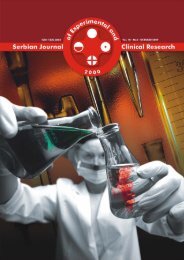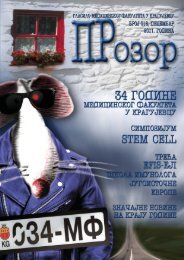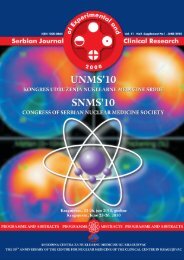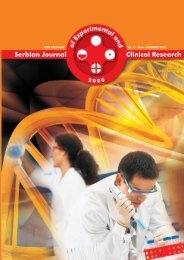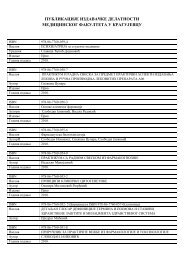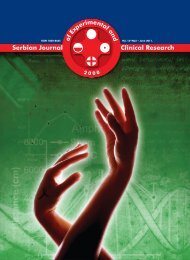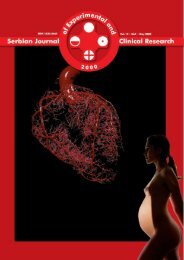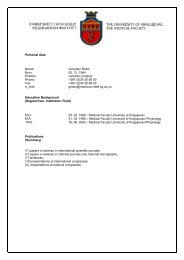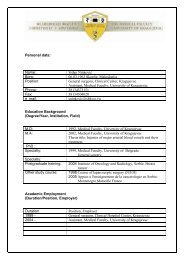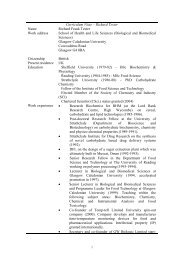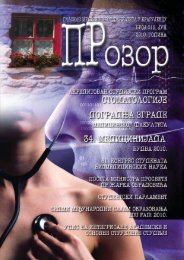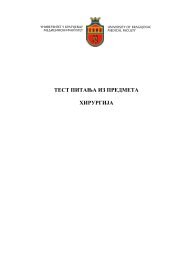neurotoxicity and mechanisms of induced hyperexcitability
neurotoxicity and mechanisms of induced hyperexcitability
neurotoxicity and mechanisms of induced hyperexcitability
You also want an ePaper? Increase the reach of your titles
YUMPU automatically turns print PDFs into web optimized ePapers that Google loves.
cysteine thiolactone (5.5 mmol/kg, i.p.). Nitro indazole isan inhibitor <strong>of</strong> neuronal nitric oxide synthase that attenuatespilocarpine-<strong>induced</strong> seizures (49). NO has been shownto modulate NMDA receptor activity by interacting withthe –SH group <strong>of</strong> its redox modulatory site via S-nitrosylation.This modification results in the downregulation <strong>of</strong>this receptor complex (19) <strong>and</strong> prevents the neurotoxic effects<strong>of</strong> an excessive Ca 2+ influx during homocysteine <strong>induced</strong>overstimulation <strong>of</strong> NMDA <strong>and</strong> mGluRs I receptors.In addition, Kim et al. (50) demonstrated that NO ameliorateshomocysteine’s adverse effects <strong>of</strong> S-nitrosylationin cultured rat cortical neurons. Moreover, NO inducesa reduction <strong>of</strong> glutamate by activation <strong>of</strong> glial cells. Manyexperimental studies have demonstrated co-localisation <strong>of</strong>NOS <strong>and</strong> GABA <strong>and</strong> have suggested that basal NO levelsinduce a depression <strong>of</strong> inhibition, while high concentrations<strong>of</strong> NO increase GABA release. In contrast to homocysteine,which increases oxidative stress by the production<strong>of</strong> reactive oxygen species, NO can act as a neuralprotector. This neuroprotective property is due to theformation <strong>of</strong> S-nitroso-L-glutathione, which is an antioxidant<strong>and</strong> NO scavenging molecule (51). However, therole <strong>of</strong> NO in epileptogenesis has been studied in differentexperimental models <strong>and</strong> reported results are highlycontradictory. Namely, the proconvulsive role <strong>of</strong> NO hasbeen demonstrated in the lindane model <strong>of</strong> convulsions<strong>and</strong> several others (52). Thus, it seems that the activity<strong>of</strong> NO depends on the animal strain, the seizure modelemployed <strong>and</strong> the type <strong>and</strong> dose <strong>of</strong> drugs used in order tomodify cerebral NO levels.Furthermore, it has been demonstrated that when L-arginine is applied alone, it significantly increases the activity<strong>of</strong> Na + /K + -ATPase activity in the hippocampus, thecortex <strong>and</strong> the brain stem. However, when L-arginine is appliedprior to D,L homocysteine thiolactone (8 mmol/kg),this completely reverses its inhibitory effect (48). The sameholds true for its effects on Mg 2+ -ATPase activity in the ratcortex <strong>and</strong> the brain stem. L-NAME increases Na + /K + -AT-Pase activity in the cortex <strong>and</strong> the brain stem but not in thehippocampus. When L-NAME was administered prior tohomocysteine thiolactone (5.5 mmol/kg), it increased theactivity <strong>of</strong> both Na + /K + -ATPase <strong>and</strong> Mg 2+ -ATPase in therat cortex <strong>and</strong> the hippocampus.Changes in total spectral power density after ethanolalone <strong>and</strong> together with D,L-homocysteine thiolactone inadult rats were examined (53). Recording electrical activityfrom the brain represents a measure <strong>of</strong> both brain function<strong>and</strong> dysfunction. Ethanol is used as a social substance <strong>and</strong> isthe second most widely used psychoactive substance in theworld after caffeine. The influence <strong>of</strong> ethanol on the centralnervous system depends on the dose, drinking pattern, tolerance<strong>and</strong> other factors. While chronic ethanol consumptionis followed by a series <strong>of</strong> seizures during the withdrawal period,acute ethanol intake exerts mainly inhibitory effects onthe CNS <strong>and</strong> is usually associated with an increase <strong>of</strong> seizurethreshold (54). Rasic-Markovic et al. (53) found that ethanol’saction on electrographic pattern is biphasic, which is characterisedby potentiation <strong>of</strong> epileptiform activity in one doserange <strong>and</strong> depression in another one. Low ethanol doses causingeuphoria <strong>and</strong> behavioural arousal are associated with desynchronisation<strong>of</strong> the EEG, decreases in the mean amplitude<strong>and</strong> increases in theta <strong>and</strong> alpha activity. In addition, ethanolincreases mean total spectral power density 15 min <strong>and</strong> 30min after administration. Ethanol affects voltage-gated ionchannels, second messenger systems <strong>and</strong> a variety <strong>of</strong> differentneurotransmitter systems such as glycine, acetylcholineas well as monoamines <strong>and</strong> neuropeptides systems (55). Twomajor amino acid neurotransmitter systems, GABA <strong>and</strong> glutamate,as well as aspartate are affected by ethanol. Acute administration<strong>of</strong> ethanol inhibits NMDA-<strong>induced</strong> Ca2+ influx,cyclic GMP production, neurotransmitter release <strong>and</strong> reducesNMDA-evoked <strong>neurotoxicity</strong> (56, 57).Pre-treatment with MK-801, which is a NMDA receptorantagonist, showed a tendency to reduced the incidence<strong>of</strong> convulsions, latency to the first seizure onset <strong>and</strong> theseverity <strong>of</strong> seizure episodes; however, there was no statisticalsignificance when compared to the D,L-homocysteinethiolactone treated group. Nevertheless, the median number<strong>of</strong> seizure episodes was significantly decreased by MK-801 when compared to the D,L-homocysteine thiolactonetreated group. On the other h<strong>and</strong>, ifenprodil, which is anothertype <strong>of</strong> NMDA receptor antagonist, decreased thelatency to the first seizure onset <strong>and</strong> increased the mediannumber <strong>of</strong> seizure episodes. The majority <strong>of</strong> seizure episodesin the ifenprodil (72.1%) <strong>and</strong> MK-801 (73.1%) groupswere significantly different compared to the D,L-homocysteinethiolactone treated group (36.0%). Our findingssuggest that D,L-homocysteine thiolactone induces seizuresthrough the stimulation <strong>of</strong> NMDA receptors in thecentral nervous system but other <strong>mechanisms</strong> (i.e., NOsignalling) may also be involved (58).Finally, limited data exist in the literature regarding theeffects <strong>of</strong> homocysteine <strong>and</strong> D,L-homocysteine thiolactoneon the activity <strong>of</strong> the acetylcholinesterase (AChE) enzymein the blood, but practically no data exist regarding the influence<strong>of</strong> these compounds on this enzyme in the brain<strong>and</strong> heart. Recent results showed a significant reduction inAChE activity in all tissues obtained from rats treated withD,L-homocysteine thiolactone compared to the enzymeactivity <strong>of</strong> the control group. In addition, these results alsoshowed that the blood enzyme activity was the lowest (12%)after treatment, while the enzyme activity was slightly higherin the brain (27.8%) <strong>and</strong> heart samples (86.3%). Therefore,it was concluded that D,L-homocysteine thiolactone significantlyinhibited AChE activity in the heart <strong>and</strong> brain tissuebut not in the blood <strong>of</strong> the rat (59).Overall, these studies clearly demonstrate that acute administration<strong>of</strong> homocysteine <strong>and</strong> especially D,L-homocysteinethiolactone elicit seizures in adult rats, affect neuronal activity,EEG recordings <strong>and</strong> behavioural responses. These effectshave been linked to the stimulation <strong>of</strong> NMDA receptors, inhibition<strong>of</strong> the Na + /K + -ATPase, inhibition <strong>of</strong> AChE activity <strong>and</strong>the functional involvement <strong>of</strong> NO during D,L-homocysteinethiolactone <strong>induced</strong> seizures in adult rats.7



